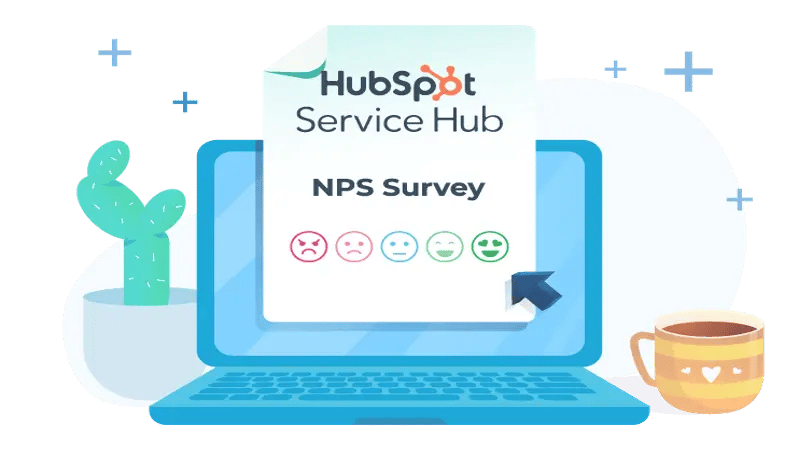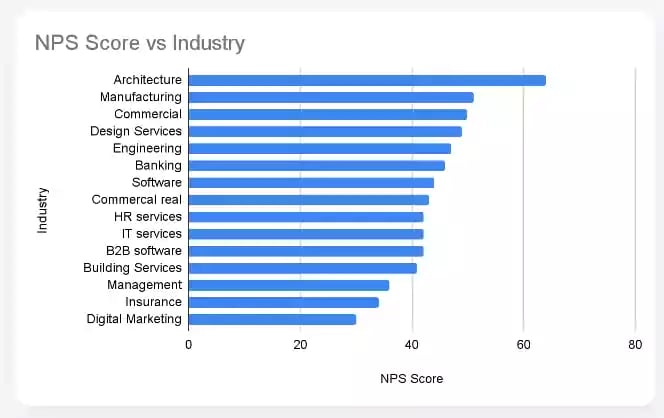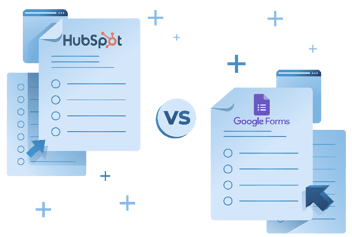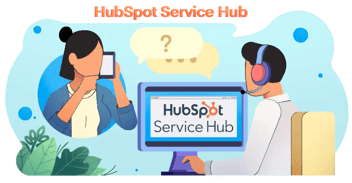How to Create Net Promoter Score Surveys with HubSpot Service Hub
Obtaining customer feedback can be challenging at times, but that feedback is significantly helpful in improving your business–particularly regarding customer service. Fortunately, Net Promoter Score® surveys simplify the customer feedback process, and tools are available to make this process even more accessible.
To gain valuable customer feedback, here's what you need to know about creating NPS surveys in the HubSpot Service Hub.

What is the Net Promoter Score Survey?
NPS (Net Promoter Score) surveys measure customer loyalty and satisfaction by asking customers, in a very standardized, single-question survey format, to rate their likelihood of recommending a product or service to others on a scale of 1-10. The net promoter system can provide valuable insights into customer perceptions and can help businesses identify areas of improvement.
The net promoter score methodology was conceived by Fred Reichheld, an American New York Times best-selling author, speaker, and business strategist. As a Bain Fellow and founder of Bain's Loyalty practice, Frederick F. Reichheld is best known for his research and writing on the loyalty business model and loyalty marketing.
NPS is also used within companies, e.g., to establish and monitor Employee Net Promoter Scores.
Aspiration Marketing measures NPS as part of our overall efforts to measure visitor and customer feedback.
NPS Surveys in HubSpot Service Hub
The HubSpot Service Hub is a customer service and support platform that allows businesses to manage customer interactions and improve the overall customer experience. With HubSpot Service Hub, businesses can create and send NPS Surveys to customers, track and analyze survey results, and use the data to improve customer service. Surveys are available in HubSpot Service Hub Enterprise and Pro level subscriptions.
Setting Up Your Survey
Once you're ready to set up your first NPS Survey in the HubSpot Platform, follow these steps:
-
Log into your HubSpot account and navigate to the Surveys & Feedback section.
-
Select "Create Survey” and choose the "NPS" template.
-
Customize the survey form by editing the survey questions and possible responses. You can also add additional questions if needed.
-
Set up triggers to send the survey to specific customers or segmented groups of customers. You can send the survey based on certain conditions, such as after a customer support ticket is closed or a customer makes a purchase.
-
Set up automatic follow-up actions based on the customer's response, such as sending follow-up emails to customers who gave a low NPS score.
-
Test the survey by sending it to a few test customers before sending it out to your entire customer base.
-
Once the survey is ready, send it to your customers and wait for the results.
-
Use the analytics tool as one of the core features in HubSpot Service Hub to measure and analyze the survey results, identify trends and areas for improvement, and track the effectiveness of changes made over time.
-
Use the feedback and suggestions from the NPS survey responses to improve customer service and continuously monitor the NPS scores to ensure improvement in customer satisfaction.
Survey Questions to Consider Using
The standard NPS question, also available in the survey template on HubSpot, is
"On a scale of 0-10, How likely is it that you would recommend <company name> to a friend or colleague?"
While you can customize the email introduction per your needs, the rating question itself is part of the standardized survey; it CANNOT be modified.
Depending on the answer category of the respondent, Detractor (score of 0 to 6), Passive (score of 7 or 8), or Promoters (score of 9 or 10), you can automate the feedback follow-up questions, e.g.,
-
Detractors: We obviously didn't do too well. Can you tell us more about your experience so we can get it right the next time?
-
Passive: All right, obviously not perfect. Can you tell us more about your experience so we can do even better next time?
-
Promoters: Thank you, sounds great. Can you tell us why you scored us so highly?
As part of the survey, you can further automate and customize the thank you note for each response category and automate the survey outreach based on customizable triggers.
As the Service Hub is fully integrated with the HubSpot CRM Solution, it is easy to take manual or automated action steps to quickly report and address potential Customer Service issues.
Analyze NPS Survey Results in HubSpot
Once you receive your NPS survey results, you'll want to analyze them. After all, the results are useless until you understand them and begin using them to change your habits and improve the customer experience.
The Net Promoter Score is a customer loyalty metric commonly used to measure customer satisfaction and gauge their willingness to recommend a product or service to others. The NPS scale, a numerical score, ranges from -100 to +100.
The Net Promoter Score calculation takes your unhappy customers and subtracts the percentage of detractors from the percentage of promoters, your most loyal customers. Customers who give a rating of 7-8 do not get included in the NPS score; see the image below as an example.
While typical B2B response rates average around 12%, Bain suggests that B2C brands aim for survey respondent rates of 40% and above.

NPS scores below zero are generally considered low, indicating a higher proportion of detractors than promoters. Good NPS Scores are those greater than 0, and high NPS scores above 50 are considered excellent.
Next, it's time to use HubSpot's analytics tools to measure and analyze your survey results. Within the HubSpot Service Hub, you can access several analytics tools to view and analyze the survey results. Here are a few ways you can use these tools to track and compare the results of your surveys:
-
View the results: Once a survey is complete, you can view the results by navigating to the Surveys & Feedback section. From there, you can see the overall NPS results, the breakdown of responses by Promoters, Passives, and Detractors, and the result of each question on the survey, and calculate your NPS score.
-
Track the scores: If you use NPS surveys regularly -you should- you can track NPS data over time and see how customer satisfaction changes. This can help you identify trends and patterns in customer feedback, such as common complaints or areas of dissatisfaction.
-
Compare results: You can also compare the results of different surveys, see your score change, and how customer satisfaction improves over time. This can help you identify the effectiveness of changes you make in customer service and track the progress over time.
-
Drill down into the data: HubSpot also allows you to drill down into the data to understand the feedback from specific groups of customers or specific locations. This can help you identify areas of improvement in specific segments of your customer base.
When comparing results and trying to understand what makes a good NPS, it is remarkable to study the differences in scores by industry. The following examples from trustmary:
2021 B2C Industry NPS Benchmarks

2021 B2B Industry NPS Benchmarks

By using these tools in the HubSpot Service Hub, you can better understand customer perceptions and use that information to improve the overall customer experience. Calculating Net Promoter Score and monitoring your trends over time should trigger improvements for best-in-class customer service.
Improving Customer Services with NPS Surveys
Once you have collected and analyzed the data from your NSP survey, it's time to use the feedback and suggestions to improve your business's customer service. It's important that when implementing change, you prioritize the most pressing issues and make changes that will have the biggest impact on the customer experience and your business as a whole.
After you implement these changes, be sure to continue to run surveys and collect NPS regularly. This will help you measure the impacts of your changes and determine whether they've been effective or need additional tweaking. In doing so, you can continuously monitor and improve your NPS scores and the customer experience.
NPS surveys are a valuable tool for surveying your customers, measuring customer satisfaction, and identifying areas for improvement within your organization, especially when combined with Employee NPS. HubSpot Service Hub allows companies to create, send, and analyze NPS surveys and use the data to improve customer service. If you're looking for an easy, cost-effective method to review and improve your customer service efforts, consider running an NPS Survey with HubSpot Service Hub.
In addition to creating custom surveys, other surveys you can set up within HubSpot include CSAT and CES Surveys.
NPS FAQs
There are a few factors to consider when deciding when to send an NPS survey:
- The customer journey: You should send an NPS survey at a point in the customer journey where you can get meaningful feedback. This could be after a customer has made a purchase, used your product or service for a certain amount of time, or interacted with your customer support team.
- The frequency: You want to avoid bombarding your customers with surveys but also want to get feedback regularly. A good rule of thumb is to send an NPS survey every 6-12 months.
- The type of survey: There are two main types of NPS surveys: relational and transactional. Relational surveys are sent to customers regularly to measure their overall satisfaction with your company. Transactional surveys are sent after a specific interaction with your company, such as a purchase or a customer support interaction.
Here are some specific examples of when you might send an NPS survey:
- After a customer makes a purchase: This is a great time to get feedback on their experience with your product or service.
- After a customer uses your product or service for a certain amount of time: This is a good time to see how they feel about your product or service over time.
- After a customer interacts with your customer support team: This is an excellent opportunity to get feedback on their customer support experience.
Ultimately, the best time to send an NPS survey is when you can get the most meaningful feedback from your customers.
HubSpot Service Hub offers several benefits for creating NPS surveys, including:
- A user-friendly interface.
- Templates and tools to help you create effective surveys.
- The ability to send surveys to specific customers or segmented groups of customers.
- Analytics tools to help you track and analyze your results.
- Integration with HubSpot CRM
There are several other tools you can use to create NPS surveys, including:
- SurveyMonkey
- Qualtrics
- Google Forms
- Typeform










Leave a Comment